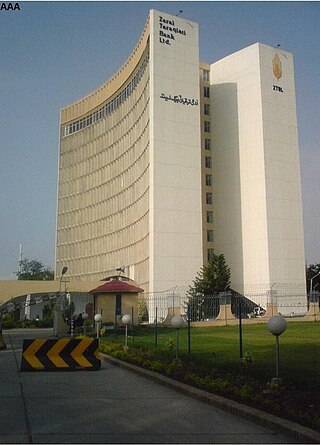
Microcredit is the extension of very small loans (microloans) to impoverished borrowers who typically lack collateral, steady employment, or a verifiable credit history. It is designed to support entrepreneurship and alleviate poverty. Many recipients are illiterate, and therefore unable to complete paperwork required to get conventional loans. As of 2009 an estimated 74 million people held microloans that totaled US$38 billion. Grameen Bank reports that repayment success rates are between 95 and 98 percent.

Microfinance is a category of financial services targeting individuals and small businesses who lack access to conventional banking and related services. Microfinance includes microcredit, the provision of small loans to poor clients; savings and checking accounts; microinsurance; and payment systems, among other services. Microfinance services are designed to reach excluded customers, usually poorer population segments, possibly socially marginalized, or geographically more isolated, and to help them become self-sufficient. ID Ghana is an example of a microfinance institution.

The Zarai Taraqiati Bank Limited (ZTBL), formerly known as Agricultural Development Bank of Pakistan, is Pakistani government-owned agricultural development bank which is based in Islamabad, Pakistan. Founded in 1961 as the agricultural development bank, the bank was renamed in 2002 as Zarai Taraqiati Bank Limited (ZTBL) and was subsequently incorporated as a public limited company in 2002 under Companies Ordinance 1984.

Cooperative banking is retail and commercial banking organized on a cooperative basis. Cooperative banking institutions take deposits and lend money in most parts of the world.

National Bank for Agriculture and Rural Development (NABARD) is an apex regulatory body for overall regulation of regional rural banks and apex cooperative banks in India. It is under the jurisdiction of Ministry of Finance, Government of India. The bank has been entrusted with "matters concerning policy, planning, and operations in the field of credit for agriculture and other economic activities in rural areas in India". NABARD is active in developing and implementing financial inclusion.

Small Industries Development Bank of India (SIDBI) is the apex regulatory body for overall licensing and regulation of micro, small and medium enterprise finance companies in India. It is under the jurisdiction of Ministry of Finance, Government of India headquartered at Lucknow and having its offices all over the country.The SIDBI was established on April 2, 1990, by Government of India, as a wholly owned subsidiary of IDBI Bank. It was delinked from IDBI w.e.f. March 27, 2000. Its purpose is to provide refinance facilities to banks and financial institutions and engage in term lending and working capital finance to industries, and serves as the principal financial institution in the Micro, Small and Medium Enterprises (MSME) sector. SIDBI also coordinates the functions of institutions engaged in similar activities. It was established in 1989, through an Act of Parliament.
Micro financing in Tanzania started in 1995 with SACCOS and NGOs. It has since then contributed to the increasing success of international micro financing. Microfinance stills remains a relatively new in Tanzania since it has not penetrated yet. Since 1995, microfinance has been linked to poverty alleviation programs and women. The government made efforts to ensure commercial banks have continued to provide financial support to the small entrepreneurial business. However a microfinance National Policy was implemented in 2002 to encourage and support microfinances in the country. Since the implementation, micro financing was officially launched and recognized as a poverty alleviation tool. Due to its increase exposure and use in the nation, commercial banks have developed interests in to offer microfinance. There are various microfinance banks that functions as supporting institutions in the country that usually provide microfinance services. These may include the CRDB, National Microfinance Bank, and AKIBA. However there are also other few banks that are concerned with micro financing in Tanzania such as the PRIDE and SEDA, Tanzania Postal Bank and FINCA. Community and small banks have also expressed interest in the same including the NGOs and other non-profit organizations.
Village banking is a microcredit methodology whereby financial services are administered locally rather than centralized in a formal bank. Village banking has its roots in ancient cultures and was most recently adopted for use by micro-finance institutions (MFIs) as a way to control costs. Early MFI village banking methods were innovated by Grameen Bank and then later developed by groups such as FINCA International founder John Hatch. Among US-based non-profit agencies there are at least 31 microfinance institutions (MFIs) that have collectively created over 800 village banking programs in at least 90 countries. And in many of these countries there are host-country MFIs—sometimes dozens—that are village banking practitioners as well.
A rotating savings and credit association (ROSCA) is a group of individuals who agree to meet for a defined period in order to save and borrow together, a form of combined peer-to-peer banking and peer-to-peer lending. Members all chip in regularly and take turns withdrawing accumulated sums.

Solidarity lending is a lending practice where small groups borrow collectively and group members encourage one another to repay. It is an important building block of microfinance.

A self-help group is a financial intermediary committee usually composed of 12 to 25 local women between the ages of 18 and 50. Most self-help groups are in India, though they can be found in other countries, especially in South Asia and Southeast Asia. A SHG is generally a group of people who work on daily wages who form a loose grouping or union. Money is collected from those who are able to donate and given to members in need.
Non-Banking Financial Company (NBFC) is a company registered under the Companies Act, 1956 of India, engaged in the business of loans and advances, acquisition of shares, stock, bonds, hire-purchase insurance business or chit-fund business, but does not include any institution whose principle business is that of agriculture, industrial activity, purchase or sale of any goods or providing any services and sale/purchase/construction of immovable property.
The Kisan Credit Card (KCC) scheme is a credit scheme introduced in August 1998 by Indian public sector banks to issue kisan credit card to the farmers of India. This model scheme was prepared by the National Bank for Agriculture and Rural Development (NABARD) on the recommendations of the R. V. Gupta Committee to provide advances for agricultural needs.

The Aryavart Bank (AB) is an Indian Regional Rural Bank (RRB) in Uttar Pradesh established on 1 April 2019. The bank was formed by the amalgamation of Gramin Bank of Aryavart and Allahabad UP Gramin Bank. It currently has 1365 branches and 22 regional offices in rural areas of Uttar Pradesh, around Lucknow.

National Housing Bank(NHB), is the apex regulatory body for overall regulation and licensing of housing finance companies in India. It is under the jurisdiction of Ministry of Finance, Government of India. It was set up on 9 July 1988 under the National Housing Bank Act, 1987. NHB is the apex financial institution for housing. NHB has been established with an objective to operate as a principal agency to promote housing finance institutions both at local and regional levels and to provide financial and other support incidental to such institutions and for matters connected therewith. The Finance Act, 2019 has amended the National Housing Bank Act, 1987. The amendment confers the powers of regulation of Housing Finance Companies (HFCs) to the Reserve Bank of India.
Poverty in Sri Lanka is 4%. Sri Lanka's life expectancy and literacy rate are nearly on par with those of developed countries, and even top the rankings for the South Asia region. While all these indicate that Sri Lanka should be experiencing a high standard of living, until recently it has only ranked in the medium category of the Human Development Index (HDI). This is despite the fact that Sri Lanka has been experiencing moderate growth in its GDP averaging 5.5 per annum between 2006 and 2009. One of the reasons is due to its relatively low GDP per capital;. The Sri Lankan government has been successful in reducing poverty from 15.2% on 2006 to 8.9% in 2010, urban poverty was reduced from 6.7 to 5.3% while rural poverty was reduced from 15.7 to 9.5%, and the nation has made significant progress towards achieving Millennium Development Goals on eradicating extreme poverty and hunger.
Priority sector lending is lending to those sectors of the economy which may not otherwise receive timely and adequate credit. This role is assigned by the Reserve Bank of India to the banks for providing a specified portion of the bank lending to few specific sectors like agriculture and allied activities, micro- and small enterprises, education, housing for the poor, and other low-income groups and weaker sections. This is essentially meant for an all-round development of the economy as opposed to focusing only on the financial sector.

Society for Elimination of Rural Poverty (SERP) is an autonomous society of the Department of Rural Development, Government of Andhra Pradesh. SERP is implementing Indira Kranthi Patham (IKP), a statewide community driven rural poverty reduction project to enable the poor to improve their livelihoods and quality of life through their own organizations. It aims to cover all the rural poor households in the state with a special focus on the poorest of the poor households. SERP also played an active part in the relief efforts taken up by the Andhra Pradesh Government during the devastating Indian Ocean tsunami in 2004.
Khayer Khal village is situated under the Maynaguri block at "Padamati I Gram Panchayat" in Jalpaiguri District, West Bengal. Its length round covers around 4-4.5km. Its total population is 2471 of which 1315 are male and 1156 female, occupying 560 households. The total families are 282 and BPL families are 237.{all data in 2006*)
Small finance banks (SFB) are a type of niche banks in India. Banks with a SFB license can provide basic banking service of acceptance of deposits and lending. The aim behind these is to provide financial inclusion to sections of the economy not being served by other banks, such as small business units, small and marginal farmers, micro and small industries and unorganised sector entities.










